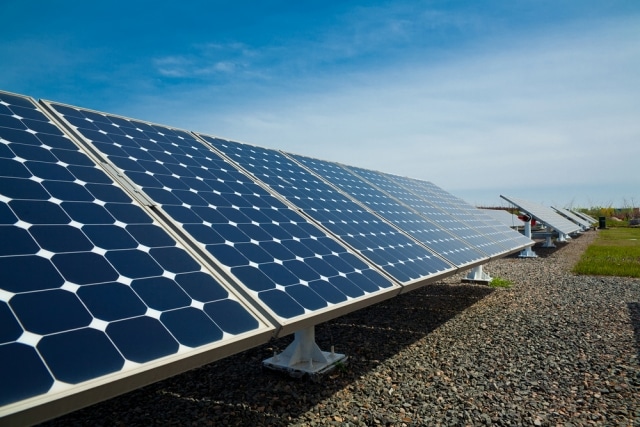Many states are already on track to meet or beat the renewable energy targets laid out for them by the EPA’s Clean Power Plan, according to a new report from Earthjustice, which is calling on the agency to strengthen the plan in order to promote more ambitious renewable energy growth.
The Clean Power Plan sets out different emissions reduction levels for each state to reach by 2030, and suggests renewable energy targets as one means of achieving those goals. But Earthjustice has found that many states have already adopted their own renewable energy standards that either meet or even exceed the suggestions made by the EPA.
Three extreme examples are California, Colorado, and Hawaii, some of the states that have done the most to embrace renewable energy. California ranks first in installed solar capacity and third in wind—it even set a record earlier this year for single-day solar photovoltaic energy generation—and has set a mandatory goal of generating 33% of its electricity from renewables by 2020. Yet the Clean Power Plan sets a standard of 21% by 2030 for the Golden State.
Colorado has a similarly ambitious self-imposed goal of 30% by 2020, but the EPA’s suggestion is also 21% by 2030. And Hawaii, which is aiming for 40% by 2030, is being urged by the Clean Power Plan to hit just 10%.
Here’s how several other clean energy early adopter states’ own commitments stack up against the goals called for in the Clean Power Plan:
- Arizona (state: 15% by 2025; EPA: 4% by 2030)
- Connecticut (state: 27% by 2020; EPA: 9% by 2030)
- Delaware (state: 25% by 2026; EPA: 12% by 2030)
- Illinois (state: 25% by 2026; EPA: 9% by 2030)
- Maine (state: 40% by 2017; EPA: 25% by 2030)
- Massachusetts (state: 22% by 2020; EPA: 24% by 2030)
- Minnesota (state: 31% by 2020; EPA: 15% by 2030)
- New York (state: 29% by 2015; EPA: 18% by 2030)
- Oregon (state: 25% by 2025; EPA: 21% by 2030)
An analysis of all 50 states’ current energy mix, renewables commitments (or lack thereof), and threats to progress can be accessed via an interactive map on Earthjustice’s website.
Meanwhile, a new report from Environment America shows that all 50 states have enough solar potential to generate more electricity than their residents consume, and that nationwide there is the solar energy potential to generate as much as 100 times the amount of energy Americans currently use.
The Clean Power Plan is not finalized yet, and the EPA is accepting public comments until December 1. Earthjustice is urging Americans to let the EPA know that states can and should aim higher. “This is the kind of thing the EPA’s comment period is really about,” Abigail Dillen, Earthjustice’s Vice President of Litigation for Climate & Energy, told DeSmog, “groundtruthing its assumptions.”
Dillen stresses that, while the Clean Power Plan needs to be far more lofty in its goals, perhaps the most important thing is that it takes effect at all if we’re going to eventually meet the emissions reductions targets climate scientists tell us are crucial: 80% below 1990 levels by 2050. “If you’re still at minimal renewables penetration in 2020 compared to where we are now,” she says, “I don’t see a path forward for hitting 80% by mid-century.”
Another benefit of the Clean Power Plan, according to Dillen: it’s forcing even the most dirty-fuel-dependent states to consider options they wouldn’t otherwise. “In some states there’s nothing to crack open the door to clean energy without this,” she says. “Florida, for instance, they likely have, between their nuclear and gas fleet, the ability to comply with the [emissions reductions] rule without switching to renewables. But they’re making an expensive choice for ratepayers. This rule makes the commission have a conversation.”
Florida, the Sunshine State, ranks seventh in the nation in terms of net generation from large-scale solar, but has no state mandate for scaling up renewables and still gets 96% of its energy from gas, coal, and nuclear. The EPA’s suggestion is that the state aim for 10% renewables by 2030.
President Obama has made the Clean Power Plan the centerpiece of his climate legacy, but Republicans, emboldened by their takeover of the Senate, have already said they aim to stop the EPA from implementing the rule. Dillen says that Obama has a credible veto threat, and she thinks it will be hard for the Republicans to get a veto-proof majority, “But they’re going to try everything they can, and they’ve made it very clear that this rule is in their crosshairs. It’s going to be very important for the White House to stand strong and the majority of Americans concerned about the climate to make it possible for their representatives to stay firm on this.”
Image Credit: wang song / Shutterstock.com
Subscribe to our newsletter
Stay up to date with DeSmog news and alerts






